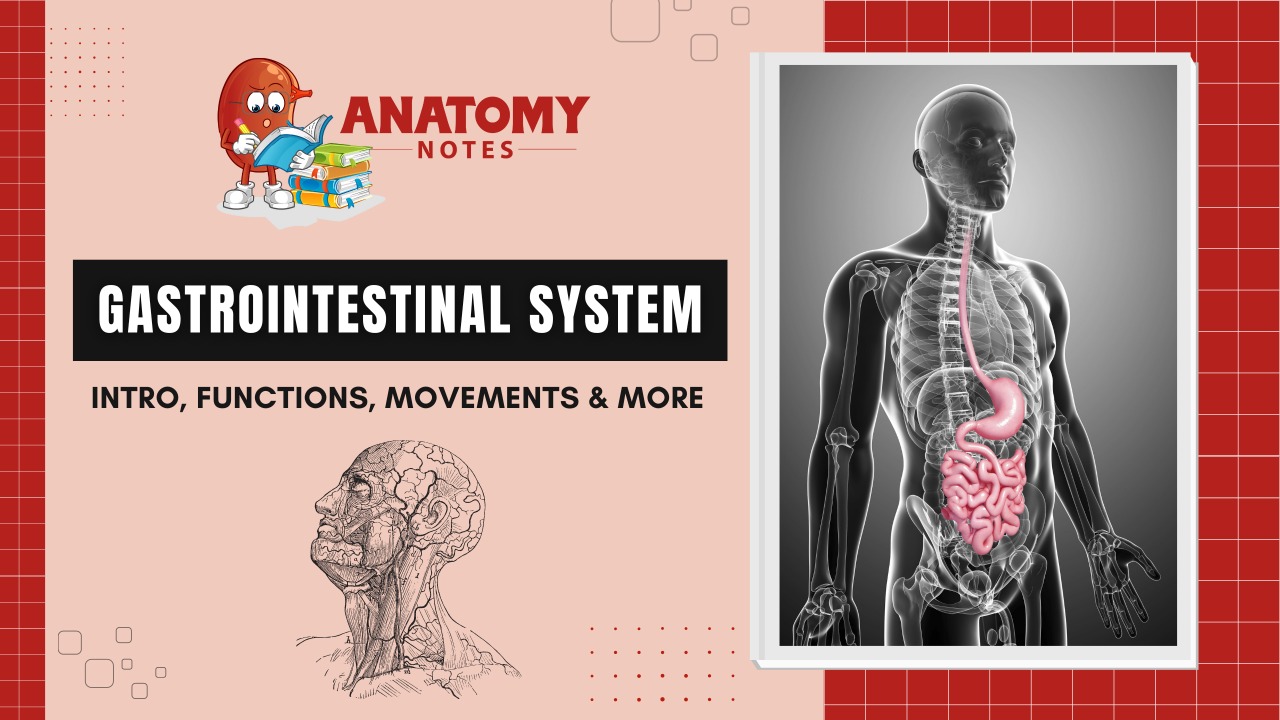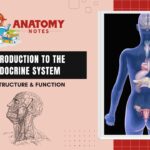The gastrointestinal system is also known as the digestive system. It is a collective name of the alimentary canal and accessory organs.
The alimentary canal forms a continuous tube that is open to the outside environment at both ends.
The organs of the alimentary canal are the mouth, pharynx, esophagus, stomach, small intestine, and large intestine.
The overall process of digestion and absorption occurs in the alimentary canal.
Accessory structures include the teeth, tongue (in the oral cavity), salivary glands, liver, gallbladder, and pancreas.
Also Read: Endocrine System – Introduction, Structure & Functions
Endocrine System – Introduction, Structure & Functions
Functions of the Digestive System
Ingestion
- The oral cavity allows food to enter the digestive tract and have mastication (chewing) occurs which resulting food bolus is swallowed.
Digestion
- Mechanical digestion – The muscular movement of the digestive tract (mainly in the oral cavity and stomach) physically break down the food into smaller particles.
- Chemical digestion – The hydrolysis reactions aided by enzymes mainly in the stomach and small intestine. Chemically break down food particles into nutrient molecules, small enough to be absorbed.
Secretion
- The enzymes and digestive fluids secreted by the digestive tract and its accessory organs facilitate chemical digestion.
Absorption
- At the end of the passage, the products or nutrients of chemical digestion From the digestive tract enters or absorb into blood or lymph to distribution to tissue cells.
Elimination
- The undigested material will be released through the rectum and anus by defecation.
Muscular movement involves the gastrointestinal tract / digestive system:-
Peristalsis
- It is a wavelike movement that occurs from the oropharynx to the rectum which allowing the gastrointestinal tract to push food particles toward the anus.
Mixing
- Mixing is a motion in the oral cavity and stomach that allows the gastrointestinal tract to repeatedly break down food into smaller particles using mechanical digestion.
Segmentation
- In the regions of the small intestine contracting and relaxing occurs independently that allowing the small intestine to digest and absorb more efficiently.
Also Read: Structure of skin – A Creature of Epidermis, Dermis and Hypodermis
Structure of skin – A Creature of Epidermis, Dermis and Hypodermis
Organs of the gastrointestinal system or digestive system:-
All digestive organs play integral roles in the life-sustaining process of digestion.
The easiest way to understand the digestive system is to divide its organs into two main categories. The first group is the organs that make up the alimentary canal.
Accessory digestive organs comprise the second group and are critical for orchestrating the breakdown of food and the assimilation of its nutrients into the body.
Accessory digestive organs, despite their name, are critical to the function of the digestive system.
Alimentary Canal Organs
It is also known as the gastrointestinal tract or gut. Ailment means “to nourish”.
The alimentary canal is the one-way tube about 7.62 meters (25 feet) in length during life and closer to 10.67 meters (35 feet) in length when measured after death, once smooth muscle tone is lost.
The main function of the organs of the alimentary canal is to nourish the body. The main parts of the alimentary canal are the following :
- Mouth or buccal cavity with tongue
- Oropharynx
- Esophagus
- Stomach
- Small intestine
- Large intestine
There are some other part in Small intestine & Large intestine
Small Intestine: the part of the intestine that runs between the stomach and the large intestine:
- Duodenum
- Jejunum & ileum
Large Intestine: The last part of the intestine which is wider and shorter than the small intestine, which consists of the cecum, colon, and rectum, which absorbs water from the material left over from digestion and prepares the faces for release from the body.
– Parts of the large intestine
- Caecum
- Ascending colon
- Transverse colon
- Descending colon
- Sigmoid colon
- Rectum
- Anal canal
Accessory organs of the digestive system
Various secretions are poured into the alimentary tract, some by glands in the lining membrane of the organs,e.g. gastric juice secreted by glands in the lining of the stomach, and some by glands situated outside the tract.
The latter are the accessory organs of digestion and their secretions pass through ducts to enter the tract. They consist of:
- 3 pairs of salivary glands
- pancreas
- liver and the biliary tract.
The organs and glands are linked physiologically as well as anatomically in that digestion and absorption occur in stages, each stage being dependent upon the previous stage or stages.
# The digestive system cannot work independently, it’s functions are cooperative with other body functions. So the contribution of another body system to the digestive system are listed below:-
| Contribution of Other Body Systems to the Digestive System | |
| Body system | Benefits received by the digestive system |
| Cardiovascular | Blood supplies digestive organs with oxygen and processed nutrients |
| Endocrine | Endocrine hormones help regulate secretion in digestive glands and accessory organs |
| Integumentary | The skin helps protect digestive organs and synthesizes vitamin D for calcium absorption |
| Lymphatic | Mucosa-associated lymphoid tissue and other lymphatic tissue defend against the entry of pathogens; lacteals absorb lipids; and lymphatic vessels transport lipids to the bloodstream |
| Muscular | Skeletal muscles support and protect abdominal organs |
| Nervous | Sensory and motor neurons help regulate secretions and muscle contractions in the digestive tract |
| Respiratory | Respiratory organs provide oxygen and remove carbon dioxide |
| Skeletal | Bones help protect and support digestive organs |
| Urinary | Kidneys convert vitamin D into its active form, allowing calcium absorption in the small intestine |
Frequently Asked Questions (FAQs)
What is the function of gastrointestinal system?
The gastrointestinal system, also known as the digestive system, functions to break down food into nutrients that can be absorbed by the body, while eliminating waste. It includes organs such as the mouth, esophagus, stomach, small and large intestines, pancreas, liver, and gallbladder.
What is gastrointestinal disease?
Gastrointestinal disease, also known as digestive system disorder, refers to a group of medical conditions that affect the digestive system organs, including the esophagus, stomach, small and large intestines, pancreas, liver, and gallbladder. Examples of gastrointestinal diseases include gastroesophageal reflux disease (GERD), peptic ulcers, inflammatory bowel disease (IBD), irritable bowel syndrome (IBS), and colon cancer, among others. These diseases can cause a wide range of symptoms, such as abdominal pain, bloating, diarrhea, constipation, nausea, vomiting, and bleeding.
What organs are in gastrointestinal system?
The gastrointestinal system, also known as the digestive system, consists of a series of organs that work together to break down food into nutrients that can be absorbed by the body, and eliminate waste. These organs include:
- Mouth
- Esophagus
- Stomach
- Small intestine (duodenum, jejunum, ileum)
- Large intestine (colon)
- Rectum
- Anus
- Liver
- Pancreas
- Gallbladder
Each of these organs plays a specific role in the digestion and absorption of nutrients, as well as the elimination of waste products from the body.
Is gastrointestinal system the same as digestive system?
Yes, the gastrointestinal system and the digestive system are the same thing. They both refer to the same set of organs and structures that work together to break down food, absorb nutrients, and eliminate waste from the body. The terms “gastrointestinal system” and “digestive system” can be used interchangeably.
What is another name for the gastrointestinal system?
Another name for the gastrointestinal system is the digestive system. The terms “gastrointestinal system” and “digestive system” are often used interchangeably to describe the same set of organs and structures involved in the digestion of food, absorption of nutrients, and elimination of waste products from the body.
Which organ produces bile?
The liver produces bile, a greenish-yellow fluid that helps to break down fats in the small intestine during the digestion process. Bile is stored in the gallbladder, a small organ located under the liver, and released into the small intestine when needed to aid in the digestion and absorption of fats.




